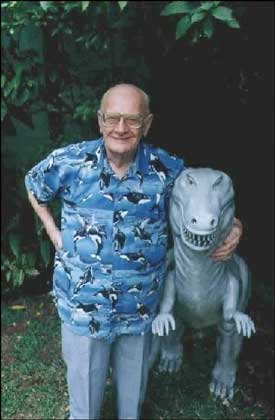The directory «Plots»
Clark Arthur Charles
(1917—2008)

Arthur C. Clarke was born in the seaside town of Minehead, Somerset, England in December 16, 1917. In 1936 he moved to London, where he joined the British Interplanetary Society. There he started to experiment with astronautic material in the BIS, write the BIS Bulletin and science fiction. During World War II, as a RAF officer, he was in charge of the first radar talk-down equipment, the Ground Controlled Approach, during its experimental trials. His only non-science-fiction novel, Glide Path, is based on this work. After the war, he returned to London and to the BIS, which he presided in 46-47 and 50-53. In 1945 he published the tecnical paper "Extra-terrestrial Relays" laying down the principles of the satellite com- munication with satellites in geostationary orbits - a speculation realized 25 years later. His invention has brought him numerous honors, such as the 1982 Marconi International Fellowship, a gold medal of the Franklin Institute, the Vikram Sarabhai Professorship of the Physical Research Laboratory, Ahmedabad, the Lindbergh Award and a Fellowship of King's College, London. Today, the geostationary orbit at 42,000 kilometers is named The Clarke Orbit by the International Astronomical Union. The first story Clarke sold professionally was "Rescue Party", written in March 1945 and appearing in Astounding Science in May 1946. He obtained first class honors in Physics and Mathematics at the King's College, London, in 1948.
In 1953 he met an American named Marilyn Torgenson, and married her less than three weeks later. They split in December 1953. As Clarke says, "The marriage was incompatibe from the beginning. It was sufficient proof that I wasn't the marrying type, although I think everybody should marry once". Clarke first visited Colombo, Sri Lanka (at the time called Ceylon) in December 1954. In 1954 Clarke wrote to Dr Harry Wexler, then chief of the Scientific Services Division, U.S. Weather Bureau, about satellite applications for weather forecasting. Of these communications, a new branch of meteorology was born, and Dr. Wexler became the driving force in using rockets and satellites for meteorological research and operations. In 1954 Clarke started to give up space for the sea. About the reasons, he said: "I now realise that it was my interest in astronautics that led me to the ocean. Both involve exploration, of course - but that's not the only reason. When the first skin-diving equipment started to appear in the late 1940s, I suddenly realized that here was a cheap and simple way of imitating one of the most magical aspects of spaceflight - weightessness." In the book Profiles of the Future (1962) he looks at the probable shape of tomorrow's world. In this book he states his three Laws: 1."When a distinguished but elderly scientist states that something is possible he is almost certainly right. When he states that something is impossible, he is very probably wrong." 2."The only way of discovering the limits of the possible is to venture a little way past them into the impossible." 3."Any sufficiently advanced technology is indistinguishable from magic." In 1964, he started to work with Stanley Kubrick in a SF movie script. After 4 years, he shared an Oscar Academy Award nomination with him for the film version of 2001: A Space Odyssey. He co-broadcasted the Apollo 11 , 12 and 15 missions with Walter Cronkite and Wally Schirra for CBS. In 1985, He published a sequel to 2001 : 2010: Odyssey Two. He worked with Peter Hyams in the movie version of 2010. They work was done using a Kaypro computer and a modem, for Arthur was in Sri Lanka and Peter Hyams in Los Angeles. Their communications turned into the book The Odyssey File - The Making of 2010. His thirteen-part TV serie Arthur C. Clarke's Mysterious World in 1981 and Arthur C. Clarke's World of strange Powers in 1984 has now been screend in many countries. He made part of other TV series about the space, as Walter Cronkite's Universe series in 1981. He has lived in Colombo, Sri Lanka since 1956 and has been doing underwater exploration along that coast and the Great Barrier Reef. So far it has been to over 70 books, almost as many non-fiction, as science fiction. In March 1998, his latest, and probably last, novel: 3001: The Final Odyssey was released.
Antigua, 2002, «2001: A Space Odyssey»
Central African Republic, 1994, «2001: A Space Odyssey»
Guinea, 2008, Arthur C. Clarke, «2001: A Space Odyssey»
Guinea, 2008, Arthur C. Clarke, «2001: A Space Odyssey»
Guinea, 2008, Roy Scheider's films
Guinea Bissau, 2009, Arthur C. Clarke
Nicaragua, 1994, «2001: A Space Odyssey»
Palau, 1999, Arthur C. Clarcke
Paraguay, 1970, Scene from «2001: A Space Odyssey»
San-Marino, 1998, «2001: A Space Odyssey»
Sao Tome e Principe, 2010, Bertrand Russell, Arthur C. Clarke
Sri Lanka, 1999, Arthur C. Clarcke
Isle of Man, 2001.01.01,  Douglas. A Space Odyssey
Douglas. A Space Odyssey